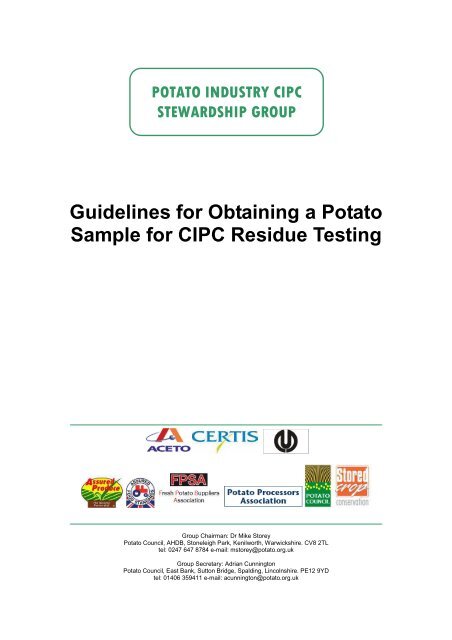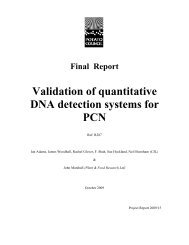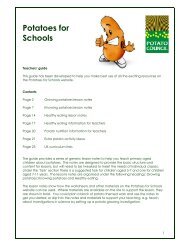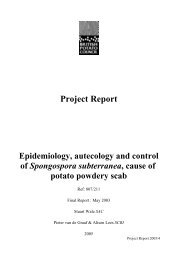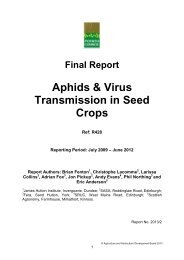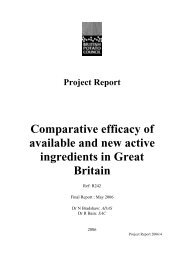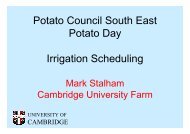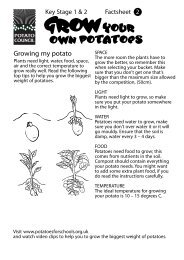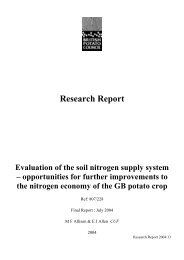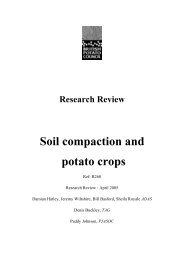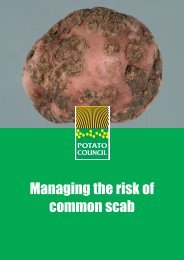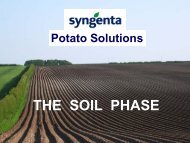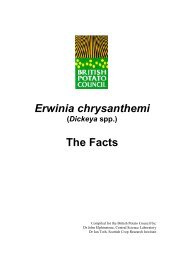Guidelines for MRL testing final - Potato Council
Guidelines for MRL testing final - Potato Council
Guidelines for MRL testing final - Potato Council
Create successful ePaper yourself
Turn your PDF publications into a flip-book with our unique Google optimized e-Paper software.
POTATO INDUSTRY CIPC<br />
STEWARDSHIP GROUP<br />
<strong>Guidelines</strong> <strong>for</strong> Obtaining a <strong>Potato</strong><br />
Sample <strong>for</strong> CIPC Residue Testing<br />
Group Chairman: Dr Mike Storey<br />
<strong>Potato</strong> <strong>Council</strong>, AHDB, Stoneleigh Park, Kenilworth, Warwickshire. CV8 2TL<br />
tel: 0247 647 8784 e-mail: mstorey@potato.org.uk<br />
Group Secretary: Adrian Cunnington<br />
<strong>Potato</strong> <strong>Council</strong>, East Bank, Sutton Bridge, Spalding, Lincolnshire. PE12 9YD<br />
tel: 01406 359411 e-mail: acunnington@potato.org.uk
<strong>Guidelines</strong> <strong>for</strong> obtaining a potato sample <strong>for</strong> CIPC<br />
residue <strong>testing</strong><br />
Following its review in the EU, CIPC (chlorpropham) has been Annex 1 listed<br />
and is covered by a Maximum Residue Level (<strong>MRL</strong>) of 10mg/kg. This <strong>MRL</strong> is<br />
not a health or safety limit, but is a concentration within which residue levels<br />
should occur if Good Agricultural Practice (defined by the product label) has<br />
been complied with. The marketing of potatoes with a residue above the <strong>MRL</strong><br />
is not permitted by law.<br />
In addition, in the UK, the use of CIPC is now controlled by the <strong>Potato</strong><br />
Industry CIPC Stewardship Group. This group, working with the Chemicals<br />
Regulation Directorate, is seeking to improve use of the chemical and<br />
minimise the risk of anomalous residue levels on potatoes.<br />
Users of the chemical should be aware that it is under threat, and that poor<br />
and unnecessary application of CIPC increases the risk of exceeding the<br />
<strong>MRL</strong>. This, in turn, would increase the likelihood that CIPC usage limits will be<br />
cut or the chemical will be withdrawn altogether.<br />
For the assessment of compliance with the <strong>MRL</strong>, a sample must be obtained<br />
in the appropriate way. The sampling procedure is detailed in European<br />
Commission directive 2002/63/EC. This, together with input from the<br />
Chemicals Regulation Directorate, has been used to draw up these<br />
guidelines.<br />
A sample must:<br />
• Consist of a minimum of 12 tubers<br />
• Weigh a minimum of 1.2 kg<br />
• All tubers of a sample must be from the same lot (e.g. Fianna from<br />
Ravens Field in store 2)<br />
• Crop must be being marketed or available <strong>for</strong> marketing (i.e. outside<br />
the withholding period <strong>for</strong> any treatments)<br />
• Tubers should be sampled by hand and be free of rots<br />
• Samples should be obtained randomly. Where a random sample<br />
cannot be obtained, then sampling should take place from the<br />
accessible portion (see p3 <strong>for</strong> guidance on obtaining a random sample)<br />
• Samples should be delivered promptly, unwashed and unprocessed to<br />
an analyst.<br />
2
Obtaining a sample from a potato store<br />
Sampling must be carried out with due regard to health and safety including<br />
the Working at Height Regulations 2005 which may limit access to some parts<br />
of stores.<br />
Box stores<br />
A random sample of 12 tubers is required. One tuber should be sampled from<br />
each of 12 boxes. Tubers should be obtained from varying depths within<br />
boxes. Only one surface tuber should be sampled – this reasonably accounts<br />
<strong>for</strong> the higher deposits of CIPC that may occur here. Only when a limited<br />
number of boxes are accessible, should more than one tuber per box be<br />
sampled.<br />
• If all box heights are accessible,<br />
using a scissor lift <strong>for</strong> example,<br />
identify 12 boxes randomly on<br />
the front, back or both faces.<br />
• If a series of fixed, stepped<br />
ladders is in the store (pictured),<br />
sample sufficient tubers from all<br />
available box heights to make up<br />
the 12 tuber sample.<br />
• Where there isn’t safe access<br />
available to boxes more than 2<br />
boxes high, it is unlikely a<br />
representative sample can be<br />
obtained. In this case it may be<br />
necessary to temporarily move<br />
boxes to ground level, <strong>for</strong> safe<br />
sampling, using a <strong>for</strong>k-lift truck.<br />
3
Bulk stores<br />
A 12 tuber sample is required. One tuber should be sampled from each of 12<br />
random positions on the top of the pile. As far as is feasible, tubers should be<br />
obtained from varying depths. If sub-surface sampling ports are available, eg<br />
in the duct wall, a tuber should be sampled from just one of these.<br />
sub-surface sampling port<br />
in store or duct wall<br />
General considerations<br />
In both types of store, it is difficult to get a representative sample because the<br />
accessible portion of the crop is a small proportion of all the potatoes stored.<br />
In all cases a more representative sample can be obtained at store unloading.<br />
However, where residue <strong>testing</strong> of stored crops is taking place, <strong>for</strong> reasons of<br />
due diligence, it is important that sampling follows the guidelines outlined in<br />
this document to ensure that any samples taken are as representative as<br />
possible.<br />
Prepared <strong>for</strong> the <strong>Potato</strong> Industry CIPC Stewardship Group by<br />
Adrian Briddon, <strong>Potato</strong> <strong>Council</strong>, Sutton Bridge.<br />
4


